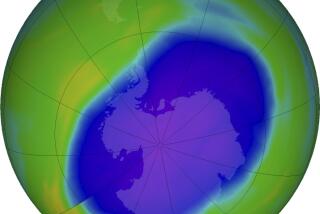Ozone Hole Called Smallest Since 1988
- Share via
WASHINGTON — This year’s Antarctic ozone hole is the smallest since 1988, but this has little to do with earthly activities and much to do with weird weather in the stratosphere, government scientists said Monday.
The ozone hole has split into two pieces, a new wrinkle on a phenomenon scientists first observed in the 1970s and have tracked as one measure of the effect of pollution.
The 2002 edition of the ozone hole covers about 6 million square miles, well below the 9 million square miles seen for the last six years at this time of year. Late September is generally the time scientists see the most ozone loss.
“This is the smallest ozone hole since 1988, but that’s still a lot of ozone loss,” said Paul Newman, an ozone researcher at NASA’s Goddard Space Flight Center outside Washington.
The ozone layer shields Earth from the sun’s ultraviolet radiation, a cause of skin cancer in humans and potentially deadly to crops and animals. Without it, there would be no life on this planet.
The small size of this year’s ozone hole is caused by unexpectedly large weather patterns in the stratosphere, the layer of the atmosphere about six miles to 30 miles above Earth’s surface where the ozone layer is found.
Normally, stratospheric weather in the extreme Southern Hemisphere is placid, allowing for a large ozone hole to open up, Newman said. This year, mammoth weather patterns pumped ozone into the southern polar region and warmed it.
“The warm air actually shuts down ozone loss,” Newman said.
The strange stratospheric weather also caused the ozone hole to divide into two lobes, instead of staying in one blob generally centered over Antarctica, he said.
The ozone hole is caused by the chemicals chlorine and bromine, which are in chlorofluorocarbons and halons, human-made chemicals once used in hair spray, refrigerators and car air conditioners.
Chlorofluorocarbons and halons were banned in 1995 because of their destructive effect on the ozone layer, but they are so long-lasting that at this rate, the ozone hole will not disappear until 2050 or so, Newman said.





